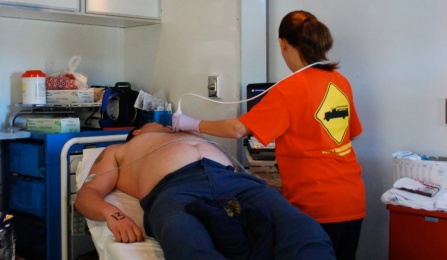Teamwork Familiarity and EMT Injuries

This study will explore possible associations between EMT partner familiarity and teamwork and on-the-job injuries.
Principal Investigator: Daniel Patterson, PhD, University of Pittsburgh
Co-investigator: Dave Hostler, PhD
Funding Agency: National Institute for Occupational Safety and Health (NIOSH)
Period: 9/2013 - 6/2014
Abstract: Emergency Medical Technicians (EMTs) are at a significantly greater risk of death and injury at work than the general population. Annually, 12.7 out of every 100,000 EMTs die in the line of duty--a rate more than twice the national workplace average. On the job illnesses, back sprains, needle sticks and other non-fatal injuries affect between three and eight out of every 100 EMTs nationwide. The annual rate of non-fatal injuries has reached epidemic proportions in some EMS agencies, where the rate has risen to over 34%.
There is reason to believe that partner familiarity and teamwork are associated with injury. In some agencies, EMTs may work with more than 50 different partners annually and have limited exposure to other partners in the agency. In these situations, EMTs may have never trained together and work with a limited understanding of their partner's expertise. Prior research in aviation link this type of configuration to accidents, errors, and poor teamwork engagement. Similar research in EMS does not exist.
We hypothesize that fatal and non-fatal EMT injuries occur more frequently among less familiar partners and among partners that fail to engage in positive teamwork behaviors such as frequent communication. We seek to accomplish the following aims:
- Examine the relationship between partner familiarity and fatal and non-fatal injuries among EMTs. For this aim, we will access a master database of employee shift records and OSHA 300 injury logs from the nation's largest ambulance corporation (www.AMR.net). A sample size of 500 EMTs gives over 99% power to detect an odds ratio of injury of 2.0 for a 1- standard deviation change in familiarity.
- Examine the relationship between partner familiarity and EMT perceptions of teamwork.
- Examine the relationship between partner familiarity, perceptions of teamwork and injuries.
We have a unique opportunity to make a significant contribution to the literature and impact the industry by establishing benchmarking data and answer questions previously unanswered in the published literature. We will use this study's findings to develop an R01 application to test the effectiveness of injury and safety programs conditioned on the relationships between partner familiarity, teamwork and injury.



